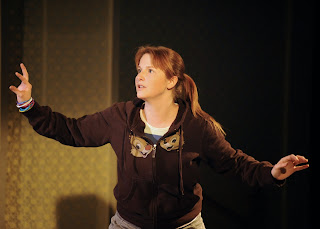Photos by Bob Goodfellow
 |
| Lisa Margolin, Jennifer Fawcett, Heather Michele Lawler. |
Theresa (Jennifer Fawcett), the oldest, is the “Olga”: a slightly untouchable mother figure and the family glue. She struggles to do as their dying mother requests, while remaining a conscience to her sisters. She is a farmer and a nun who isn’t afraid to ask questions, her tolerance unending.
Agnes (Lisa Margolin) is the middle child, the “Masha”: a black sheep of the family. An actress who has experienced the quicker lane of life and been thrown from the highway at least a handful of times. She is selfish and a stubborn alcoholic.
Louise (Heather Lawler), the youngest, is the “Irina” of the family. She is on sensitivity overload, shy and kind and almost overlooked at times. She is addicted to the impossible scenarios of the soap operas she watches, seemingly escaping the truth of existence, unable to cope.
Tested by the failing health of their mother and her dying wish that the girls “reconcile” with their father, these three estranged sisters are reunited. Tragedy allowed them to face their past, their choices, and to let life and love occur, embracing it together.
The main playing area is the kitchen and dining room of their mother’s home. The look was, on the whole, aesthetically appropriate. The cabinets colored a robin’s egg blue and yellow, the floor tiled with browns and greys, the wall paper a dated, lacey yellowish hue. Yet, at moments, the wall paper became a scrim which allowed the audience to see what was happening while Louise was sucked into the television (adding a welcome secret shape to a fairly two dimensional set) and even allowed for an artistic mode of transitions between scenes. There was an element of shadow work done during the transitions. We’d see the outline of Louise handling the bell her mother used to call her daughters in her sickest hours, Theresa folding sheets, taking care of the world… I wished, however, that this had been more interlaced throughout the show. Perhaps to see Louise’s slow, grieving silhouette, while Agnes and Theresa converse in the main playing area, moving on. The visual of the dark outline of a body full of fear and grace was a treat I wanted more of.
Even though the place we were in never changed, there was a need for transitions between scenes. The Mumford & Sons soundscape was a fitting modern folk sound, with old-timey overtones. The music seemed full of tentative memory as it was coupled with the shadow of a sister. Unfortunately, the final transition was something we hadn’t yet seen, and as it only happened once, it stuck out. It felt incomplete, and I mourned that in the final moments of the show. I wish that this moment grew out of the shadow work, or was an echo of an earlier, established vehicle.
The audience gets to see each sister describe how the wheels turn in their minds in asides where they individually own the stage for a few minutes. Each is trapped, unable to truly communicate with the others, so these monologues allow the audience to see their truer, better nature. It was hard to sympathize with these frustrating women at times, so seeing the good in them was very much welcome.
Lisa Margolin had an ease on the stage. Her comic timing was well done and her physicality helpful in pinpointing her character. However, there were times this reviewer hoped to see more depth to Agnes. There was a specific moment in the first half where she and her older sister spoke about a choice Agnes felt she was forced to make when she was much younger. This scene felt sedentary, and lacked the high stakes I yearned for. It felt more like an anecdote, a story she was telling: not the heartbroken reality she was living. Margolin’s transition from a selfish alcoholic actor to a more centered, yet still “unconventional” mother character was very well done, however, and helped the audience to sympathize with her more.
Jennifer Fawcett’s portrayal of Theresa was subtle and appropriate. At first, it was hard to soften to her as she was oppressive in an “I’m disappointed in you” kind of way. Fawcett was a bit stiff at first, but as we moved through the piece, there was a perceivable shift. She portrayed the family glue, but was no stereotypical “sister.” She got angry and she got funny and she got broken. A particular monologue in the second half of the show, where she spoke about God (or the seeming lack of God), gave me pause. It was honest and she fought her desperation without reveling in it.
 |
| Heather Michele Lawler |
Marion Bridge is a wonderful script, an older story re-told with contemporary spice. I was happy to be able to focus on these three women, unmuddied by menfolk and heads of family. We get to see just them. Only them. How grief can maim, but how it also can aid in the healing of relationships and dreams and mistakes.
Marion Bridge runs through April 13 at Riverside Theatre. More information here.

No comments:
Post a Comment